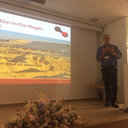Epidemiological, diagnostic, clinical, and therapeutic aspects of Brucella bacteremia in children in southern Israel: a 7-year retrospective study (2005-2011).
Ključne riječi
Sažetak
BACKGROUND
Data on the various aspects of brucellosis in children living in southern Israel are missing.
OBJECTIVE
Our aim was to study the epidemiological, microbiological, diagnostic, clinical, therapeutic and outcome features of brucellosis in children <19 years of age in southern Israel during 2005-2011.
METHODS
The study population included all patients hospitalized with a diagnosis of brucellosis, established according to a clinical presentation compatible with brucellosis+presence of Brucella bacteremia (BB).
RESULTS
A total of 128 (50.8%) of 252 patients admitted with a diagnosis of brucellosis had BB (all with Brucella melitensis). All patients were of Muslim Bedouin ethnicity. The mean incidence of BB in southern Israel was 16 cases/100,000 Bedouin, with no significant changes during the study period. Overall duration of symptoms before diagnosis was 10.1±10.9 days. Fever at diagnosis was recorded in <20% of the patients. The most frequent symptoms were arthralgia (61.7%), weakness (32.8%), gastrointestinal disturbances (27.3%), myalgia (25%), and headache (18.8%). The main clinical findings included monoarthritis (36.7%), hepatosplenomegaly (25%), lymphadenopathy (17.2%), heart murmur (11.7%), and skin rash (9.4%), respectively. Anemia, leukopenia, thrombocytopenia, and pancytopenia were reported in 17.6%, 29.6%, 12.8%, and 2.3% of the patients, respectively. Twenty-nine (30.5%) patients with BB had serum agglutinin titers ≤1/160 (13, 13.7%%, had titers <1/160). Twenty-seven (93%) of the 29 patients aged 0-4 years were treated with gentamicin and trimethoprim-sulfamethoxazole; a total of 77 (60.2%) patients received gentamicin and doxycycline.
CONCLUSIONS
Childhood brucellosis remains an important public health problem in southern Israel. BB was diagnosed in >50% of the children with brucellosis, and B. melitensis was identified in all cases. Arthralgia, weakness, and gastrointestinal complaints were the most common symptoms, and monoarthritis, hepatosplenomegaly, and lymphadenopathy were the most common clinical findings. A considerable number of patients with BB had undetectable/low serum agglutinin titers, suggesting insufficient reliability on serology alone in diagnosis of brucellosis.



